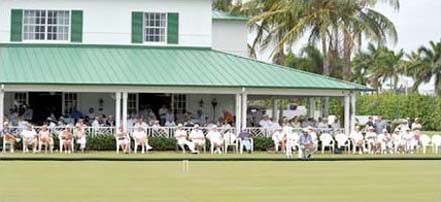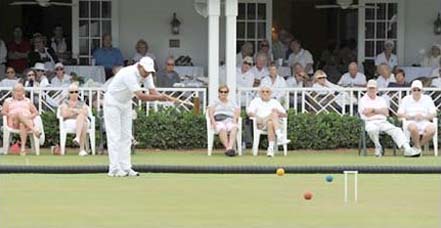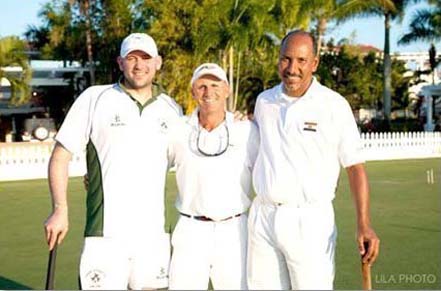

|
Back to |
| The Front Page |
| News & Features |

|
Your perfect event, Part One: "Thirsty Crowkay" and world-class Golf Croquet |
||||||||
|
By Bob Alman Posted September 18, 2016
|
||||||||
|
||||||||
A couple of decades ago I asked a San Francisco-trained national champion why he retired from competition at the height of his celebrity. He told me simply, "All I can do now is lose." When a skill or an enterprise or an event peaks to perfection it inevitably begins a decline--unless you end it at the peak. That's what happened to the San Francisco Open, retired in 2000 after it's 16th edition, because the production committee--including the above-referenced champion--couldn't figure out any way to improve it. But the journey to perfection is a priceless trip in itself, for an individual, an organization, or a croquet program. We asked several people who created their own "perfect event" over a period of trial, error and correction to share their stories. We start in Part One with two programs for Golf Croquet--one for novices in Australia and one in South Florida for the best players in the world
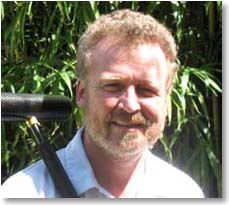
|
| Nicholls, who just turned 50, changes his beard more often than his mallet. He's been playing with his Pidcock since 2011 and doesn't intend to switch any time soon. As one of the top players in Australia he has become the face of croquet in Wagga Wagga. |
It started when he quipped to the local brewer of the Thirsty Crow Brewery at their tasting event, "There should be a Thirsty Crowquet Club." At the time the brewer had never played croquet, so Nicholls invited the key brewing staff to his three-court public club, and "over a few beers with a few of his mates" Jim taught them all the basics of Golf Croquet.
Jim is an excellent teacher, a fan of beers, and impossible to dislike. They were all hooked. So when Craig Wealands confided that his brewery was looking for a way to have a social event outside the brewery premises and support some kind of local organization, the deal was struck.
Jim and Craig quickly sketched out an event that would fill the bill for both organizations: The club would supply the courts, clubhouse, equipment, and games, and the brewer would supply the beer and pizza, as well as Jim's "coaching" crew for the group--the staff from the brewery who would thus broaden their relationship with their best customers.
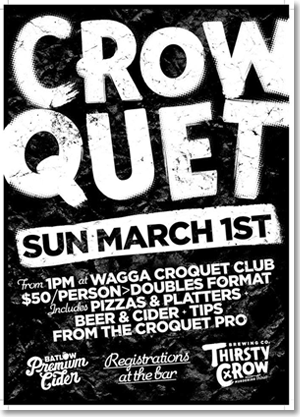
|
The brewer would also supply the group--mostly the young working professionals already in their marketing outreach. The participants would pay $50/person for the four-hour event--including beer, pizza, croquet and plenty of socializing and networking, with all the enrollment done by the brewer, while most of the revenue would go to the croquet club.
The format decided upon was an abridged version of Golf Croquet doubles, played as "first to four hoops." Deciding the duration of the event would be easy--determined by the number of kegs of beer supplied--which usually turned out to be three or four hours.
Making it work for the players and the club
Over the past five years, the Wagga Wagga club has steadily developed their facility, refurbished their small clubhouse and acquired enough equipment to cater for events and tournaments for up to 50 participants.
The "Thirsty Crowquet" event begins with Jim teaching basic skills--including jump shots and clearings--and a casual round-robin that enables newcomers to learn to compete successfully. After a casual round-robin comes a pizza break, and then the cutthroat knockout competition, with the draw based on the brewer's unique and very strange ranking system. ("Questioning the system seems to increase the likelihood of being drawn to play against the local pro in the first round," Jim explains with a wink.)
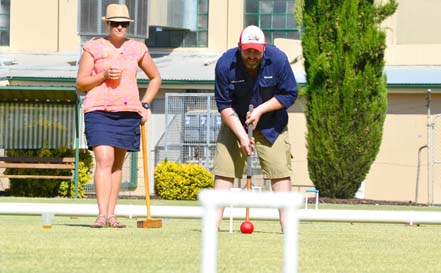
|
| Brewer Craig Wealands takes the social game of Thirsty Crowquet very seriously. As in most countries, you have to put the beer in plastic for lawn play in a "pat, chat, and drink" event. In Wagga Wagga the local rule is "Don't spill any on the lawn--it would be a waste of good beer." |
Contemporary pop music is played via loud speaker across the lawns. The players are allowed to play in bare feet or flip-flops, and the dress code is casual - although some do make the effort to sport a "team uniform" of their own choosing.
Winners get no more than the glory of victory--which means a lot if you're looking to be a hero to a potential date!-- but each participant is given a coupon offering a discount for a business or social booking at the croquet club.
The client does the lion's share of promotion
The event has been solely promoted through the brewery via poster, Facebook and emailing lists. People register and pay the fee, which helps with catering costs. And everybody wins:
* The club promotes croquet to the wider community, gets a mallet into the hands of people outside the traditional demographics (that is, younger than 50!) and generates additional income from business and social bookings and potential members..
* The brewer gets all the good will that accrues from giving their customer base a different and memorable experience. Their reputation and visibility is advanced in the community among individuals, couples, businesses and organizations.
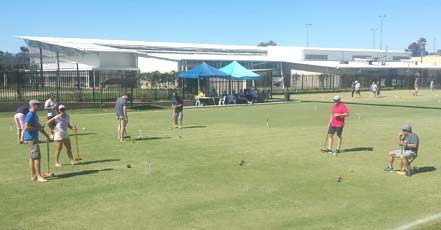
|
| Young professionals are playing Golf Croquet in Nicholls' sponsored program on the lawns of the Wagga Wagga Croquet Club. |
Jim explains, "The people who visit breweries are not just the regular beer-drinkers; by nature they're willing to try new things, and they're from a diverse range of backgrounds. We've had teachers, agronomists, university students, nurses, army and air force personnel, real estate agents--and the list goes on--all playing croquet together.
"Perhaps the greatest measure of our success has been the feedback from people discovering what a wonderful, nasty, tactical, strategic game croquet is, and wanting to come back for more."
Much to be learned, details to be adjusted
The main adjustments have been refining the format to provide everyone with the right amount of croquet. Playing "first to four" keeps the afternoon moving, yet still provides plenty of social interaction.
For groups of 30 or fewer, full-sized courts are used, doubled banked, with two round-robins of doubles on each lawn. (All the team members play with each other, in four rounds of first-to-four games--then the brewer determines the knockout draw.) With larger groups, half-courts can be used just as well.
Both the club and the brewery aim to have two or three "Thirsty Crowquet" events a year. When patrons ask the brewery, "When is the next croquet event?" that question generates the next calendar date along with more promotion of croquet by the brewery to its lists--and thus to local business houses and social groups who might want to have their own croquet event--with or without beer and pizza.
The event has primarily focused on promoting croquet as a social enterprise. While locals will continue to attend future Thirsty Crowquet events and generating revenue for the club, there has not yet been an influx of new club members from attendees taking up the game seriously--only enquiry to learn more about croquet. Typically the organizers of the different "teams" are strongly focused on work and other activities--but Jim envisions a further evolution of the program, through regular "team competitions" and eventually a new class of club membership.
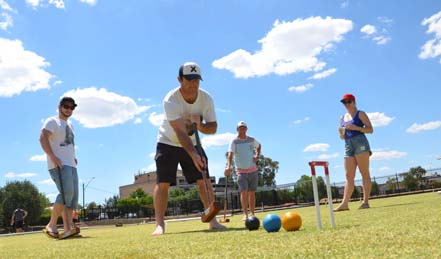
|
| This could be a template for demographic expansion worldwide: casual dress code, social play, intense competition--and the possibility of getting a date. |
With ongoing enquiry for the event, the spin-off events, and the word-of-mouth promotion of croquet, Jim and the club are confident that this one event will spawn more/similar activity in Wagga Wagga--which, fortunately, is a "small" news market, ensuring that the club is getting lots of local publicity. The Wagga Wagga Team Competition for local businesses could become a local staple, building over the season, bringing in more and more groups, generating more publicity, and ending with a large team knockout competition to determine the local champions--all good fodder for local publicity every time it happens.
|
Sponsorship for novice events may provide revenue for the club, outreach into the community and publicity for everyone. At the other end of the spectrum, it could provide a purse to attract good players, not just for the cash, but for the glory of winning "the big money." In Australia, the best example of that may be the Dixon Advisory Classic hosted by Cammeray Croquet Club.
In America, there's another precedent for sponsor money attracting good players--the best in the world. It was last played in 2012, but Rick Landry intends to revive it. In the sport of croquet, the amount of cash doesn't have to be large. In fact, the glamour of limited-entry invitationals is sufficient to attract the best in the world for top cash purses of as little as $8,000. |
|
"Golf Croquet Champion of Champions Invitational" set for revival
The International Polo Club Palm Beach (IPC) in Wellington, Florida inaugurated a croquet invitational in the fall of 2007. The owner of the elegant complex agreed with local member and croquet player Don Jacobsen that the one-lawn club could host an event for very little investment which could become the most prestigious croquet competition in the world. Only eight players would be invited, and they would come for the perfect lawn and beautiful surroundings--drawn by a modest purse. All the players in 2007 were Americans. Leo McBride came down from Canada and won the event. For the fall of 2008, the purse was doubled, with the winner to get $5,000. Almost all the players were Americans, and Ben Rothman won the $5,000 purse. There was no event in 2009, because the schedule was switched to spring, which meant a February date in 2010 would work best. Ron Lloyd came down from Pinehurst to direct the event, still played in Association Croquet, double-banked, with all the games at IPC. The caliber of the players was higher in 2010--all but one of whom was in the world top 100-- including two players from Europe. American Danny Huneycutt, who had brought down his SuperHoops for the event, defeated local pro David Bent in the finals, so he took home the $5,000 top prize. Rick Landry began as croquet pro at Polo in 2010, and Bob Alman was enlisted to help re-shape and upgrade the event. Jacobson finally agreed, with the assistance of a very persuasive David McCoy (IPC member, president of the Croquet Foundation of America and General Manager of the National Croquet Center) to switch the game to Golf Croquet, and the "re-launch" was scheduled for the spring of 2011--this time with a purse of $8,000! The year 2011 saw a real breakthrough in the quality of players and the international stature of the event. Bob Alman posted an announcement on croquet's Nottingham Board and helped the Polo staff vet the players who should be invited. Rick, Bob, and David agreed on the perfect format, taking lessons from the previous years. One "good idea" the organizers agreed on was to use Egyptian balls--which kind of made sense, because they were so lively. Clearings would be so much better and the game so much more "authentic" with Egyptian balls. We tested them at Dave Bent's facility, and made sure we had at least two sets for the tournaments. Reg Bamford expressed misgivings about the balls, but it turned out he couldn't attend; Egyptian balls were fine with everyone else--and as it turned out, no one broke a mallet on them. The main problem with the Egyptian balls was their lack of uniformity; setting the hoops for them wasn't easy, but in the 2011 event, they were used for all the games Tony Stephens came from New Zealand, Stephen Mulliner flew in from England, along with Rachel Rowe, who had qualified by beating Reg Bamford in the Ascot, England's virtual "championship" of Golf Croquet. Mulliner won the $5,000 purse in a best-of-three finals against David Maloof. (Maloof and Bent were substituted for the two Egyptians originally invited who couldn't come because of the Arab Spring unrest in the region.) Formatting for maximum impact So by 2012, the quality of the players was fully commensurate with the intention of the organizers to have the world's most prestigious invitational, a true "championship of champions," with the world champion in attendance and national champions drawn from around the globe. We would use three courts at the National Croquet Center on three days to have a very fine schedule that would surely produce a fair result.
Egyptian balls were not used to be used. Instead, our standard stock of Sunshineys were brought into play. After only one day, we questioned this decision closely. Mulliner defeated McInerney in a huge upset, as it happened, and McInerney later commented that he wouldn't have won the event if we had used Sunshineys throughout. We quickly switched to Dawson balls after confirming with all the players that the Dawsons were needed to assure the rebound needed for clearing shots in the competition. Three courts at the National Croquet Center were donated to the event, courtesy of the Croquet Foundation of America, who thus became a co-sponsor of the event. On the first day of play, a round-robin of single first-to-seven games was played at IPC, doubled-banked on the single extraordinarily fine court, and finished on time. That let the players get to know each other and practice seriously, with the results of the round robin deciding the seeding of the eight-player knock-out to follow.
The second, third, and fourth day incorporated the three courts at the National Croquet Center. On Day Four, a Saturday, an exhibition match between the reigning world champion and a three-time world champion from Egypt was publicized for midday at the National Croquet Center. A huge crowd by croquet standards--perhaps 200--came to watch what turned out to be an hour-long game. Bob Alman organized play-by-play over loud-speakers on the veranda and chatted with WCF President Amir Ramsis, USCA president Johnny Mitchell, and General Manager of the NCC David McCoy--with respectful attention to the games so as not to distract the players at critical moments. Younis narrowly won a fast-moving and exciting game. It was already known that the two competitors would be the finalists at IPC the next day, Sunday.
McInerney won the event, taking two of the three games from Younis. The event was now perfected. Every player in the world would clamor to come to next year's event. But then, disaster stuck: IPC's owner was removed from management for legal reasons and replaced by an absentee committee. They decided to concentrate on polo alone. It's something that happens predictably in organizations in crisis, but it was terribly disappointing to the organizers. There was no way to communicate effectively to the new management that this event had achieved a top position in the world, for very little investment, and should be continued. After IPC was subsequently sold, in 2015, the overall tennis and croquet pro, Paul Hope, moved to the nearby Palm Beach Polo and Country Club, which has plenty of tennis and four croquet courts. (The USCA was headquartered there before the National Croquet Center was built.) And Rick Landry became the pro at the National Croquet Center. The revival strategy is under way Landry wants to revive the Golf Croquet Champion of Champions Invitational and has begun looking for new sponsorship. He's aiming to increase the purse to $10,000 to finance "guaranteed appearance" money for top competitors, so they won't have to win purse money to pay their expenses. The top four players out of the block would play two semi-finals and a final to determine prize money for first, second, third and fourth. The event will again be promoted through club websites, online croquet publications, the USCA and many other associations around the world. Some of the past sponsors for croquet in South Florida have been Jaguar, Land Rover, and Longines watches. These were all successful events, measured by the feedback from the players, sponsors, and spectators. Sponsors provide the purse money to generate the most prestigious event in the croquet world and get good publicity, access and strong on-site presence for their participation. Landry comments, "After seven years. I feel this event has really been perfected. Now we have something to show potential sponsors. I have confidence that we can really build on what we've learned. For example, we could have bleachers at the National Croquet Center to accommodate larger crowds. We could even include Palm Beach Polo, with their four croquet courts, if they want to be a major sponsor for the event." Landry is optimistic: "The only thing needed to re-start this great event is private or corporate underwriting for the prize money that will guarantee its future success." Before the 2013 event was canceled, a major figure in the USCA had already committed to raising $5,000 to produce a video of one of the top games. The video would be used to promote the sport of croquet to new audiences and especially to the media. So the potential is there for any corporate sponsor to get a super bargain for a small investment; and for the sport of croquet to achieve a higher exposure and expanded acceptance among the public. The only question to be answered is: Who wants to finance the most prestigious croquet invitational in the world and glorify their brand in the process? |
